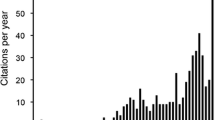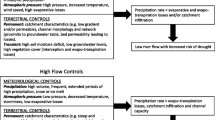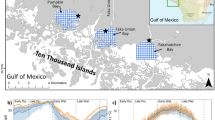Abstract
Pacific salmon (Oncorhynchus spp.) disturb sediments and fertilize streams with marine-derived nutrients during their annual spawning runs, leading researchers to classify these fish as ecosystem engineers and providers of resource subsidies. While these processes strongly influence the structure and function of salmon streams, the magnitude of salmon influence varies widely across studies. Here, we use meta-analysis to evaluate potential sources of variability among studies in stream ecosystem responses to salmon. Results obtained from 37 publications that collectively included 79 streams revealed positive, but highly inconsistent, overall effects of salmon on dissolved nutrients, sediment biofilm, macroinvertebrates, resident fish, and isotopic enrichment. Variation in these response variables was commonly influenced by salmon biomass, stream discharge, sediment size, and whether studies used artificial carcass treatments or observed a natural spawning run. Dissolved nutrients were positively related to salmon biomass per unit discharge, and the slope of the relationship for natural runs was five to ten times higher than for carcass additions. Mean effects on ammonium and phosphorus were also greater for natural runs than carcass additions, an effect attributable to excretion by live salmon. In contrast, we observed larger positive effects on benthic macroinvertebrates for carcass additions than for natural runs, likely because disturbance by live salmon was absent. Furthermore, benthic macroinvertebrates and biofilm associated with small sediments (<32 mm) displayed a negative response to salmon while those associated with large sediments (>32 mm) showed a positive response. This comprehensive analysis is the first to quantitatively identify environmental and methodological variables that influence the observed effects of salmon. Identifying sources of variation in salmon–stream interactions is a critical step toward understanding why engineering and subsidy effects vary so dramatically over space and time, and toward developing management strategies that will preserve the ecological integrity of salmon streams.






Similar content being viewed by others
References
Alba-Lynn C, Detling JK (2008) Interactive disturbance effects of two disparate ecosystem engineers in North American shortgrass steppe. Oecologia 157:269–278
Ambrose HE, Wilzbach MA, Cummins KW (2004) Periphyton response to increased light and salmon carcass introduction in northern California streams. J North Am Benthol Soc 23:701–712
Arnqvist G, Wooster D (1995) Meta-analysis: synthesizing research findings in ecology and evolution. Trends Ecol Evol 10:236–240
Augerot X (2005) Atlas of Pacific Salmon: the first map-based status assessment of salmon in the North Pacific. University of California Press, Berkeley
Behnke RJ (2002) Trout and salmon of North America. Free Press, New York
Bilby RE, Fransen BR, Bisson PA (1996) Incorporation of nitrogen and carbon from spawning coho salmon into the trophic system of small streams: evidence from stable isotopes. Can J Fish Aquat Sci 53:164–173
Bilby RE, Fransen BR, Bisson PA, Walter JK (1998) Response of juvenile coho salmon (Oncorhynchus kisutch) and steelhead (Oncorhynchus mykiss) to the addition of salmon carcasses to two streams in southwestern Washington, USA. Can J Fish Aquat Sci 55:1909–1918
Bilby RE, Fransen BR, Cederholm JK, Scarlett WJ (2001) Preliminary evaluation of the use of nitrogen stable isotope ratios to establish escapement levels for Pacific salmon. Fisheries 26:6–14
Cederholm CJ, Houston DB, Cole CL, Scarlett WJ (1989) Fate of coho salmon (Oncorhynchus kisutch) carcasses in spawning streams. Can J Fish Aquat Sci 46:1348–1355
Cederholm CJ, Kunze MD, Murota T, Sibatani A (1999) Pacific salmon carcasses: essential contributions of nutrients and energy for aquatic and terrestrial ecosystems. Fisheries 24:6–15
Chaloner DT, Martin KM, Wipfli MS, Ostrom PH, Lamberti GA (2002) Marine carbon and nitrogen in southeastern Alaska stream food webs: evidence from artificial and natural streams. Can J Fish Aquat Sci 59:1257–1265
Chaloner DT, Lamberti GA, Merritt RW, Mitchell NL, Ostrom PH, Wipfli MS (2004) Variation in responses to spawning Pacific salmon among three south-eastern Alaska streams. Freshw Biol 49:587–599
Chaloner DT, Lamberti GA, Cak AD, Blair NL, Edwards RT (2007) Inter-annual variation in responses of water chemistry and epilithon to Pacific salmon spawners in an Alaskan stream. Freshw Biol 52:478–490
Compton JE, Andersen CP, Phillips DL, Brooks JR, Johnson MG, Church MR, Hogsett WE, Cairns MA, Rygiewicz PT, McComb BC, Shaff CD (2006) Ecological and water quality consequences of nutrient addition for salmon restoration in the Pacific Northwest. Front Ecol Environ 4:18–26
Crawford SS (2001) Salmonine introductions to the Laurentian Great Lakes: an historical review and evaluation of ecological effects. Canadian Special Publication of Fisheries and Aquatic Sciences, vol 132. NRC, Ottawa
Crooks JA (2002) Characterizing ecosystem-level consequences of biological invasions: the role of ecosystem engineers. Oikos 97:153–166
Diamond J (1986) Overview: laboratory experiments, field experiments, and natural experiments. In: Diamond J, Case TJ (eds) Community ecology. Harper and Row, New York, pp 3–22
Eastman DE (1996) Response of freshwater fish communities to spawning sockeye salmon (Oncorhynchus nerka). MS Thesis, University of Washington, Seattle
Finney BP, Gregory-Eaves I, Sweetman J, Dougas MSV, Smol JP (2000) Impacts of climatic change and fishing on Pacific salmon abundance over the past 300 years. Science 290:795–799
Flecker AS (1996) Ecosystem engineering by a dominant detritivore in a diverse tropical stream. Ecology 77:1845–1854
Gende SM, Edwards RT, Willson MF, Wipfli MS (2002) Pacific salmon in aquatic and terrestrial ecosystems. BioScience 52:917–928
Gresh T, Lichatowich J, Schoonmaker P (2000) An estimation of historic and current levels of salmon production in the Northeast Pacific ecosystem: evidence of a nutrient deficit in the freshwater systems of the Pacific Northwest. Fisheries 25:15–21
Groot C, Margolis L (1991) Pacific salmon life histories. University of British Columbia Press, Vancouver
Gurevitch J, Hedges LV (2001) Meta-analysis: combining the results of independent experiments. In: Scheiner SM, Gurevitch J (eds) Design and analysis of ecological experiments, 2nd edn. Oxford University Press, Oxford, pp 347–369
Gurevitch J, Morrow LL, Wallace A, Walsh JS (1992) A meta-analysis of competition in field experiments. Am Nat 140:539–572
Hassan MA, Gottesfeld AS, Montgomery DR, Tunnicliffe JF, Clarke GKC, Wynn G, Jones-Cox H, Poirier R, MacIsaac E, Herunter H, Macdonald SJ (2008) Salmon-driven bed load transport and bed morphology in mountain streams. Geophys Res Lett 35:L04405
Hedges LV, Olkin I (1985) Statistical methods for meta-analysis. Academic, Orlando
Hedges LV, Gurevitch J, Curtis PS (1999) The meta-analysis of response ratios in experimental ecology. Ecology 80:1150–1156
Jones CG, Lawton JH, Shachak M (1994) Organisms as ecosystem engineers. Oikos 69:373–386
Jones CG, Lawton JH, Shachak M (1997) Positive and negative effects of organisms as physical ecosystem engineers. Ecology 78:1946–1957
Kitchell JF, Schindler DE, Herwig BR, Post DM, Olson MH, Oldham M (1999) Nutrient cycling at the landscape level: the role of diel foraging migrations by geese at the Bosque del Apache National Wildlife Refuge, New Mexico. Limnol Oceanogr 44:828–836
Kohler AE, Rugenski A, Taki D (2008) Stream food web response to a salmon carcass analogue addition in two central Idaho, USA streams. Freshw Biol 53:446–460
Kondolf GM, Wolman MG (1993) The sizes of salmonid spawning gravels. Water Resour Res 29:2275–2285
Krümmel EM, Gregory-Eaves I, MacDonald RW, Kimpe LE, Demers MJ, Smol JP, Finney B, Blais JM (2005) Concentrations and fluxes of salmon-derived polychlorinated biphenyls (PCBs) in lake sediments. Environ Sci Technol 39:7020–7026
Lackey RT (2003) Nutrient addition to restore salmon runs: considerations for developing environmental protection policies and regulations. In: Stockner JG (ed) Nutrients in salmonid ecosystems: sustaining production and biodiversity. American Fisheries Society, Symposium 34, Bethesda, pp 283–285
Lamberti GA, Steinman AD (1993) Research in artificial streams: applications, uses, and abuses. J North Am Benthol Soc 12:313–384
Langellotto GA, Denno RF (2004) Responses of invertebrate natural enemies to complex-structured habitats: a meta-analytical synthesis. Oecologia 139:1–10
Levin SA (1992) The problem of pattern and scale in ecology. Ecology 73:1947–1967
Marczak LB, Thompson RM, Richardson JS (2007) Meta-analysis: trophic level, habitat, and productivity shape the food web effects of resource subsidies. Ecology 88:140–148
Menge BA, Sutherland JP (1987) Community regulation: variation in disturbance, competition, and predation in relation to environmental stress and recruitment. Am Nat 130:730–757
Minakawa N, Gara RI (1999) Ecological effects of a chum salmon (Oncorhynchus keta) spawning run in a small stream of the Pacific Northwest. J Freshw Ecol 14:327–335
Minakawa N, Gara RI (2005) Spatial and temporal distribution of coho salmon carcasses in a stream in the Pacific Northwest, USA. Hydrobiologia 539:163–166
Mitchell NL, Lamberti GA (2005) Responses in dissolved nutrients and epilithon abundance to spawning salmon in southeast Alaska streams. Limnol Oceanogr 50:217–227
Moore JW (2006) Animal ecosystem engineers in streams. BioScience 56:237–246
Moore JW, Schindler DE, Scheuerell MD (2004) Disturbance of freshwater habitats by anadromous salmon in Alaska. Oecologia 139:298–308
Moore JW, Schindler DE, Carter JL, Fox J, Griffiths J, Holtgrieve GW (2007) Biotic control of stream fluxes: spawning salmon drive nutrient and matter export. Ecology 88:1278–1291
Naiman RJ, Johnston CA, Kelley JC (1988) Alteration of North American streams by beaver. BioScience 38:753–762
Naiman RJ, Bilby RE, Schindler DE, Helfield JM (2002) Pacific salmon, nutrients, and the dynamics of freshwater and riparian ecosystems. Ecosystems 5:399–417
Osenberg CW, Sarnelle O, Cooper SD, Holt RD (1999) Resolving ecological questions through meta-analysis: goals, metrics, and models. Ecology 80:1105–1117
Oswood MW (1997) Streams and rivers in Alaska: a high latitude perspective on running waters. In: Milner AM, Oswood MW (eds) Freshwaters of Alaska: ecological syntheses. Springer, New York, pp 331–356
Peterson DP, Foote CJ (2000) Disturbance of small-stream habitat by spawning sockeye salmon in Alaska. Trans Am Fish Soc 129:924–934
Poff NL, Allan JD, Bain MB, Karr JR, Prestegaard KL, Richter BD, Sparks RE, Stromberg JC (1997) The natural flow regime. BioScience 47:769–784
Polis GA, Hurd SD (1995) Extraordinarily high spider densities on islands: flow of energy from the marine to terrestrial food webs and the absence of predation. Proc Natl Acad Sci USA 92:4382–4386
Polis GA, Anderson WB, Holt RD (1997) Toward an integration of landscape and food web ecology: the dynamics of spatially subsidized food webs. Annu Rev Ecol Syst 28:289–316
Polis GA, Power ME, Huxel GR (eds) (2004) Food webs at the landscape level. University of Chicago Press, Chicago
Quinn TP (2005) The behavior and ecology of Pacific salmon and trout. University of Washington Press, Seattle
Rosenberg MS, Adams DC, Gurevitch J (2000) MetaWin statistical software for meta-analysis version 2. Sinauer, Sunderland
Scheuerell MD, Moore JW, Schindler DE, Harvey CJ (2007) Varying effects of anadromous sockeye salmon on the trophic ecology of two species of resident salmonids in southwest Alaska. Freshw Biol 52:1944–1956
Schindler DE, Scheuerell MD, Moore JW, Gende SM, Francis TB, Palen WJ (2003) Pacific salmon and the ecology of coastal ecosystems. Front Ecol Environ 1:31–37
Stockner JG (ed) (2003) Nutrients in salmonid ecosystems: sustaining production and biodiversity. American Fisheries Society, Symposium 34, Bethesda
Stockner JG, MacIsaac EA (1996) British Columbia lake enrichment programme: two decades of habitat enhancement for sockeye salmon. Regul Rivers Res Manag 12:547–561
Stockner JG, Rydin E, Hyenstrand P (2000) Cultural oligotrophication: causes and consequences for fisheries resources. Fisheries 25:7–14
Thayer CW (1979) Biological bulldozers and the evolution of marine benthic communities. Science 203:458–461
Tiegs SD, Chaloner DT, Levi P, Rueegg J, Tank JL, Lamberti GA (2008) Timber harvest transforms ecological roles of salmon in Southeast Alaska rain forest streams. Ecol Appl 18:4–11
Vanni MJ (2002) Nutrient cycling by animals in freshwater ecosystems. Annu Rev Ecol Syst 33:341–370
Vanni MJ, DeAngelis DL, Schindler DE, Huxel GR (2004) Overview: cross-habitat flux of nutrients and detritus. In: Polis GA, Power ME, Huxel GR (eds) Food webs at the landscape level. University of Chicago Press, Chicago, pp 3–11
Vitousek PM, Aber JD, Howarth RW, Likens GE, Matson PA, Schindler DW, Schlesinger WH, Tilman DG (1997) Human alteration of the global nitrogen cycle: sources and consequences. Ecol Appl 7:737–750
Wentworth CK (1922) A scale of grade and class terms for clastic sediments. J Geol 30:377–392
Whicker AD, Detling JK (1988) Ecological consequences of prairie dog disturbances. BioScience 38:778–785
Willson MF, Gende SM, Marston BH (1998) Fishes and the forest. BioScience 48:455–462
Willson MF, Gende SM, Bisson PA (2004) Anadromous fishes as ecological links between ocean, fresh water, and land. In: Polis GA, Power ME, Huxel GR (eds) Food webs at the landscape level. University of Chicago Press, Chicago, pp 284–300
Wilzbach MA, Harvey BC, White JL, Nakamoto RJ (2005) Effects of riparian canopy opening and salmon carcass addition on the abundance and growth of resident salmonids. Can J Fish Aquat Sci 62:58–67
Wipfli MS, Hudson JP, Caouette JP (1998) Influence of salmon carcasses on stream productivity: response of biofilm and benthic macroinvertebrates in southeastern Alaska, USA. Can J Fish Aquat Sci 55:1503–1511
Wipfli MS, Hudson JP, Chaloner DT, Caouette JP (1999) Influence of salmon spawner densities on stream productivity in Southeast Alaska. Can J Fish Aquat Sci 56:1600–1611
Wipfli MS, Hudson JP, Caouette JP, Chaloner DT (2003) Marine subsidies in freshwater ecosystems: salmon carcasses increase the growth rates of stream-resident salmonids. Trans Am Fish Soc 132:371–381
Wright JP, Jones CG (2004) Predicting effects of ecosystem engineers on patch-scale species richness from primary productivity. Ecology 85:2071–2081
Zar JH (1999) Biostatistical analysis, 4th edn. Prentice-Hall, Upper Saddle River
Acknowledgments
We acknowledge three anonymous reviewers for providing suggestions that greatly improved the manuscript. We also thank members of the Stream Ecology Laboratory at the University of Notre Dame, as well as Peter Levi, David Lodge, and Jason McLachlan. Mark Drew generously performed GIS analyses and generated the map of study locations, and Matthew Goslin assisted with salmon distribution meta-data. Michael Brueseke, Susanne Hebbler, Margaret O’Sullivan, and Alexander Reisinger assisted with data extraction and management. Jared Aldstadt, Jessica Gurevitch, Laurie Marczak, and Michael Rosenberg kindly provided important insights regarding methodological questions. We also thank Shannon Claeson, Larry Hanne, JoAnna Lessard, and Margaret Wilzbach for providing unpublished data. Funding was provided by the USDA-CSREES National Research Initiative Competitive Grants Program (Managed Ecosystems Program 2006-35101-16566) and the Great Lakes Fishery Trust (Project 2007.857). D.J.J. was also supported by fellowships from the Center for Aquatic Conservation at the University of Notre Dame and the Peter J. Schmitt Foundation.
Author information
Authors and Affiliations
Corresponding author
Additional information
Communicated by Marc Mangel.
Electronic supplementary material
Rights and permissions
About this article
Cite this article
Janetski, D.J., Chaloner, D.T., Tiegs, S.D. et al. Pacific salmon effects on stream ecosystems: a quantitative synthesis. Oecologia 159, 583–595 (2009). https://doi.org/10.1007/s00442-008-1249-x
Received:
Accepted:
Published:
Issue Date:
DOI: https://doi.org/10.1007/s00442-008-1249-x




